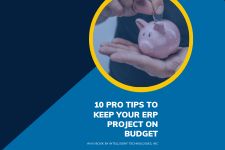ERP Pricing Demystified
Unlock the Mystery of ERP Pricing: The Ultimate Guide for Business Leaders
Explore by Category
Our Picks by Category
Featured Video
Small businesses often struggle with finding affordable software solutions that meet their needs. Enterprise-level ERP solutions can be too expensive and complex. However, there are alternatives. To find the right fit, SMBs should consider the type of deployment, modules needed, pricing plans, and team onboarding when evaluating ERP costs. With careful planning and the right implementation partner, ERPs can deliver surprising benefits to any SMB.
ERP Buying and Licensing FAQs
What are the typical costs associated with ERP software licensing and pricing?
The costs associated with ERP software licensing and pricing can vary widely depending on the vendor, the complexity of the software, and the number of users. However, in general, companies can expect to pay a significant upfront cost for licensing and implementation, as well as ongoing fees for maintenance, upgrades, and support.
How are ERP software licensing and pricing determined?
ERP software licensing and pricing are determined by a variety of factors, including the number of users, the level of functionality required, the complexity of the implementation, and the vendor’s pricing model. Some vendors may charge per user, while others may charge based on the number of transactions, modules or features required.
Are there any hidden costs associated with ERP software licensing and pricing?
Though they aren’t necessarily hidden, there are some costs that are less obvious than others. A few common ones include additional fees for customization, training, and support. It’s important to carefully review any pricing proposals and contracts to understand all costs associated with the software.
What are the different types of ERP software licensing and pricing models?
The most common types of ERP software licensing and pricing models include perpetual licensing, subscription-based pricing, and usage-based pricing. Perpetual licensing involves a one-time upfront cost for the software license, while subscription-based pricing involves ongoing monthly or yearly fees. Usage-based pricing charges customers based on the number of users or transactions processed.
What are the key factors that influence ERP software licensing and pricing?
The key factors that influence ERP software licensing and pricing include the number of users, the level of functionality required, the complexity of the implementation, and the vendor’s pricing model.
How do ERP software vendors typically handle software upgrades and maintenance fees?
ERP software vendors typically handle software upgrades and maintenance fees through ongoing support contracts. These contracts may include regular updates and maintenance, as well as access to technical support. It’s important to carefully review these contracts to understand what is included and any associated costs.
What are the advantages and disadvantages of different ERP software licensing and pricing models?
The advantages of perpetual licensing include a one-time upfront cost and full ownership of the software license. Subscription-based pricing offers more flexibility and can be less expensive in the short-term, but can result in higher overall costs over time. Usage-based pricing is ideal for companies with fluctuating needs but can be more difficult to budget for. It’s important to carefully evaluate each model to determine which is best suited to the company’s needs.
How do cloud-based ERP software licensing and pricing differ from traditional on-premise solutions?
Cloud-based ERP software licensing and pricing typically involves a subscription-based model, where companies pay a monthly or yearly fee for access to the software. Traditional on-premise solutions, on the other hand, typically involve a one-time upfront cost for licensing and implementation.
Most Popular Articles

Dynamics GP User Types Explained
Reading Time: 3 minutes
ERP Cost Comparison: Cloud vs On-Premises
Reading time: 6 minutes
Microsoft Dynamics GP Licensing Options
Reading time: 3 minutes
How Much Does a New ERP Cost? Part 1: TCO
Reading time: 4 minutes
Latest Articles
Vivid Reports On: Choosing The Right Financial Reporting Software Step-By-Step
In the data-driven business landscape, financial reporting software is vital for streamlining processes, enhancing accuracy, and enabling informed decisions. Amidst a plethora of options, selecting the ideal financial reporting software can be daunting. Our guide offers valuable insights, aiding you in making an informed decision aligned with your business needs, ensuring optimal performance.
Stay On Track: ERP Budgeting Best Practices for Maximum Cost Savings
Explore key ERP budgeting best practices to maximize cost savings. Learn to plan effectively, choose the right ERP system, manage projects efficiently, mitigate risks, handle vendors, and ensure testing and quality assurance. Discover ongoing monitoring and optimization strategies to maintain budget compliance and achieve successful implementation. Download our comprehensive guide now!
How Much Does Acumatica Cost?: A Guide for Decision Makers
Knowing the cost of Acumatica ERP is critical for businesses looking to implement this popular software to grow their organization, especially given the many factors that contribute to varying costs between businesses. To help you understand Acumatica’s unique pricing structure, we’ve compiled everything about Acumatica ERP, including the factors influencing the price and additional costs to consider.
All Articles On How ERP Pricing Works
- How Much Does ERP Cost?
- ERP Cost for Small Business: 4 Key Factors
- How Do You Properly Compare Software Vendor Quotes?
- What Factors Affect the Cost of ERP Software?
- Why is ERP So Expensive? Top Costs to Consider.
- ERP Software Pricing Models Explained
- How to Choose Between SaaS and Perpetual ERP Licenses
- Cost Comparison Between Cloud and On-Premise ERPs
- ERP Cost: How Much Will You Really Pay?
- ERP Software Pricing Guide: Anatomy of a Software Quote
- ERP Cost Comparison: Which is Cheaper: Cloud or On-Premises?
- Legacy or Cloud, Which Costs More? An ERP System Cost Comparison
- How Much Does a New ERP Cost? Part One: TCO
- How Much Does a New ERP Cost? Part Two: ROI










